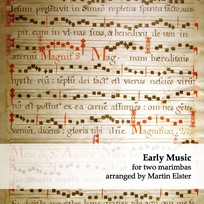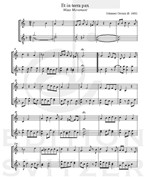
Early Music
Composer: Various
Instrument: Marimba Duo
Level: Intermediate
Published: 2014
Price: €45.00
Item details
-
Description +
-
Arranged by Martin Elster
Duration: 30 min.
he inspiration for this book came from an assignment. Al Lepak (my percussion teacher at Hartt) asked me to play a piece without bar lines, something I had never before encountered. It was a fantasia for three viols by Orlando di Lasso, which I performed with 2 other percussionists on marimba, vibraphone, and glockenspiel. This was the beginning of my fascination for medieval and Renaissance music.
A few years later, when a lutist whom I knew invited me to join his early music group, I jumped at the opportunity. We read through a lot of music while playing at medieval banquets every weekend for a couple of years. And the more I played it, the more I loved it. Subsequently, I began arranging many of these tunes for marimba duo, which I performed in various venues with a fellow percussionist.
Now, if you were to ask me, Why play early Occidental music on an instrument of African origin whose modern form was developed in the U.S. c. 1910? I would answer: Why not?! In fact, this music sounds fantastic on marimba! But don’t take my word for it. Try it for yourselves!
You will find in this collection pieces from England, France, Germany, Italy, and Spain, ranging from the earliest extant keyboard music (“Organ Estampie”) to a courante by Handel. Also here are a dozen songs from the late fourteenth century French-Cypriot repertory. These lyrical, highly rhythmic pieces are in a style that has come to be known as ars subtilior (“the subtle art”). You will hear cross-rhythms, bird calls, and jazzy syncopation in these ballades, virelais, and rondeaux.
The capital letters at the beginning of the ballades and rondeaux represent the form. For example, in the virelai “Or sus vous dormes trop,” the “A” section is played once through; then the “B” section is played twice (with 1st and 2nd endings); then the “A” section is played twice, ending at the “Fine.”
Tempi, dynamics, rolls, and other musical considerations (such as musica ficta) are for you to experiment with. All of the pieces in this book can be played on two standard 4 octave marimbas.
The sources for these arrangements include the Historical Anthology of Music by Archibald T. Davison and Willi Apel (Harvard University Press), French Secular Music of the Late Fourteenth Century edited by Willi Apel (Medieval Academy of America), and the Glogauer Liederbuch (Anonymous).
Special thanks to my friend and colleague, Steve Liebman, who first introduced me to many of these tunes.
Martin Elster
Contents
Organ Estampie
Amor c’al tuo suggetto
Et in terra pax
Le ray au soleyl
Da’n gui seus
En vous amer
Je la veul toustans servir
Mon cuer s’enfuit de fortune en bon port
Notes pour moi
Onques ne fu
Or sus vous dormes trop
Plus onques dame
Que Pena Major (V)
Qui d’a mours
S’en vous
Tres gentil cuer
O Rosa Bella
Ma maitresse
Mit ganczem Willen
Alta
Frau, ich bin euch von Herzen hold
Hans Beutler, der wollt’ reiten aus
Ich schnell’ mein Horn in Jammers Ton
Im Maien
La Caccia
Il Doloroso
La Girandola
Il Grillo
Il Lamento
La Rondinella
La Sampogna
La Sirena
La Torello
What If I Never Speed
Fantasia
Courante
-
-
Instrumentation +
-
Two Marimbas
-
-
Reviews +
-
Review (Percussive Notes, July 2016)
This unique collection of early music arranged/adapted by Martin Elster for two marimbas will certainly introduce most percussionists/listeners to music composed prior to the Baroque era. While there is nothing unusual about this collection, it will permit the duo performers to become more familiar and cognizant of the harmonic wealth and diverse styles of the music from this lesser- performed historical era.
Included in this collection are 36 duets for potential consideration as either sight-reading or recital material. Among the selections are an organ estampie circa 1325, movements from liturgical masses dating from 1400, and such secular selections as dance movements from the late 14th century. Although most duets in this collection are modal, arranger Martin Elster has provided musica ficta (notated flats/sharps) realization, which creates a more major tonality sense for many of these duets. These duets are drawn from music of the pre-Baroque era from England, France, Germany, Italy, and Spain. Only two-mallet technique is necessary for each marimbist. This collection could be appropriate for pre-college performance study or even for the younger collegiate duo.
—Jim Lambert
-
-
Credits +
-
Front Cover graphics and layout: Ronni Kot Wenzell
Engraving: Martin Elster
Printed in Copenhagen, Denmark
Copyright © Edition SVITZER
www.editionsvitzer.com
-



